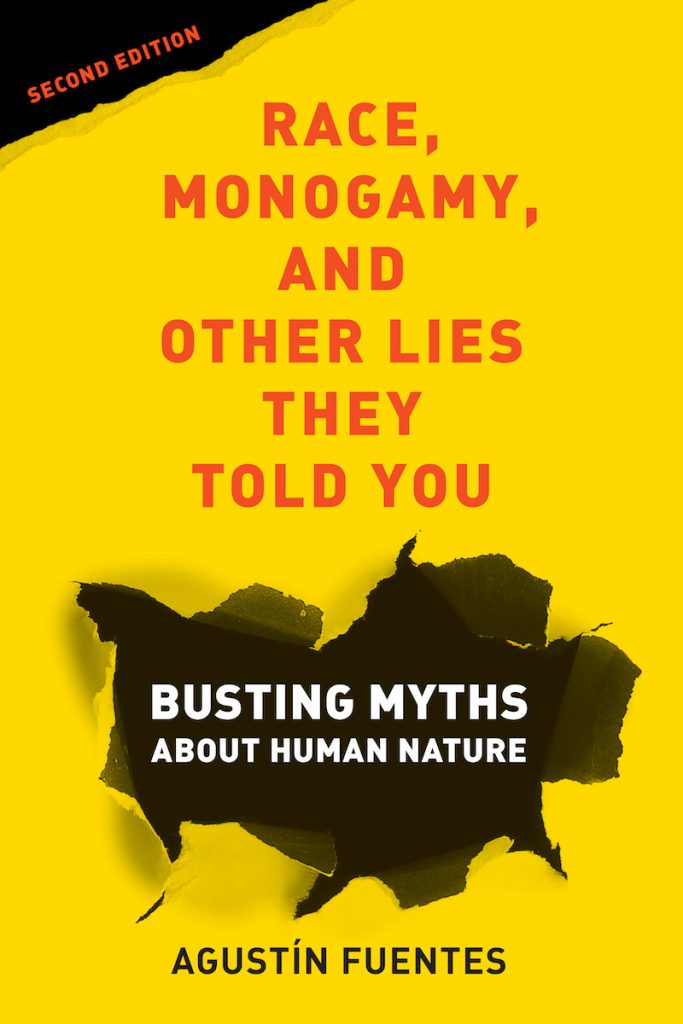Busting Myths About Sex and Gender

Excerpted from the second edition of Race, Monogamy, and Other Lies They Told You. © 2022 by Agustín Fuentes. Published by the University of California Press. All rights reserved.
A few decades ago, author and family therapist John Gray published the first edition of his book Men Are From Mars, Women Are from Venus, which argues that to make male-female romantic relationships work, one needs to realize the natural differences in communication, emotion, and behavioral styles between males and females. More than 25 years later, this ideology of difference still reflects a common way people think about men and women.
The belief that men are by nature aggressive and belligerent but protectors—like the Roman god of war, Mars—and women are emotive, beautiful, vain, and fertile—like the goddess of love, Venus—is common. Such a belief is often rooted in stories about human evolution and offered as an explanation of why men and women have different jobs, different capacities, and different participation in politics and industry.
This is a dangerous myth.
What we actually know about men and women, and the nature of sex in humans, challenges popular views of these differences and denies any simplistic take on this topic. To bust the myths about sex and gender, we have to test core assumptions and refute them.
BUSTING MYTHS ABOUT SEX AND THE BRAIN
It is a common assumption that parts of the male and female brain have evolved to focus on different things: that men seek sex, competition, and status, and women seek protection and security, to be social and caretaking. There is near total agreement in this view; men and women want different things out of life and sex. This is a basis for misogyny, incels, and hate.
Because of the assumptions about how males and females differ in behavior, there has been an intensive search for measurable biological differences in men’s and women’s brains. The results, as neuroscientist Lise Eliot points out, are negligible:
“What I found after an exhaustive search was surprisingly little solid evidence of sex differences in children’s brains. Sure, there are studies that do find differences, but when I looked closely at all the data—not just the research that confirms what we already know about boys’ and girls’ behavior but a truly balanced collection of findings—I had to admit that only two facts have been reliably proven: boys’ brains are larger than girls, and girls’ brains finish growing earlier than boys. Overall male/female brain differences appear trivial and population-specific. The human brain is not ‘sexually dimorphic.’”
For example, for over 100 years the corpus callosum was supposed to be the Holy Grail of brain differences between males and females. The corpus callosum’s nerve fibers reach out like tendrils into the parts of the brain, acting as the mediator of signals between the left and right hemispheres.
In the 1990s, a number of publications purported to show size differences between men and women in the corpus callosum. Their assumption was that a larger splenium (the rear part of the corpus callosum, where it is at its thickest) would indicate a more robust set of connections and maybe reflect better kinds of social or empathetic skills. The argument was that women have a larger splenium than men, and thus better integrative, or holistic, thinking skills.
In 1997, psychologists Katherine Bishop and Douglas Wahlsten examined studies on the corpus callosum and came to the following conclusion: “A meta-analysis of 49 studies published since 1980 reveals no significant sex difference in the size or shape of the splenium of the corpus callosum, whether or not an appropriate adjustment is made for brain size.”
In addition, over the past few centuries there have been many studies of the brains of cadavers, and since the 1980s, researchers have been able to use various imaging technologies to examine the brains of living individuals. The end result is that aside from size (on average), there does not seem to be any clear pattern or consistent indication of structural differences that can be tied to biological male-female distinctions.
The bottom line is, as Eliot and colleagues note, the structures of the brain are no more “male” or “female” than are the liver or kidneys or heart. However, there are some patterns of differences in some ways in which brains respond to stimuli, especially in adults. This is because, as neuroscientist Gina Rippon notes, “a gendered world will produce a gendered brain.”
WHAT ARE SEX AND GENDER?
Recent work in biology and genetics clearly demonstrates that biological sex is not best envisioned as a binary (XX versus XY) but rather as a broad spectrum of developmental patterns and processes. To varying extents, many of us are biological hybrids on a male-female continuum.
Most of the variation is minor, and individuals more or less conform to a general division based on which genitals one has (which is not a definition of biological sex), but with a range of variation in things like hormone levels and function, physical developmental patterns, hair growth, and other physiological processes. This is a normal part of the biological processes of being human and reflects a flexible system of reproductive development.
Read more from this author: “Biology Rejects the Sex Binary, and That’s Good for Humanity”
Gender is a culturally influenced perception of the roles the range of sexes are expected to play. In many societies, gender is best conceived of as a continuum, not a dichotomy. “Gender” and “sex” are related, entangled even, but not the same thing.
Most recently the term gender/sex is used by researchers because the term recognizes that the biological and the sociocultural are typically inseparable. Humans are naturenurtural—a true synthesis and fusion of nature and nurture. It is best to think of gender/sex as a dynamic system of interaction rather than one physical part (biological sex) and one cultural part (gender); in humans, you can’t have one without the other.
BUSTING MYTHS ABOUT MALE AND FEMALE BEHAVIORS
Researchers know that men, on average, are taller and heavier. But are men and women really different when it comes to IQ or mathematical and scientific ability? Can evolutionary differences explain male-female differences in skill and behavior?
In groundbreaking work, psychologist Janet Shibley Hyde analyzed psychological studies to find out how much men and women actually differ in their abilities. In her 2005 study, she conducted an overview of psychological and standardized assessments of cognitive variables (math, verbal, spatial), communication (verbal and nonverbal), social and personality variables (aggression, negotiation, helping, sexuality, leadership, introversion/extroversion), psychological well-being, motor behaviors (throwing, balance, flexibility, et cetera), and a few others (moral reasoning, cheating behavior, et cetera.).
Shibley Hyde examined 46 meta-analyses of male-female differences (published between 1980 and 2004), consisting of nearly 5,000 reports. In comparing the reports, Shibley Hyde used the d measure, which reflects how far apart the male and female averages are in standardized units. She found that in 78 percent of the meta-analyses, the d measures are close to zero or small.
Where are the large gender differences? Males scored noticeably higher in grip strength, sprinting, throwing velocity and throwing distance, masturbation, views on casual sex, physical aggression, and mental rotation of objects. Females scored higher on indirect aggression, agreeableness, and smiling.
Recently, psychologist Ethan Zell and colleagues retested and expanded on Shibley Hyde’s key assessments. They analyzed data from more than 20,000 studies involving over 12 million participants, and they concluded that “across most topic areas in psychological science, the difference between males and females is small or very small.”
WHERE DO GENDER DIFFERENCES COME FROM?
While we see infants through gendered eyes, infants do not have full-blown gendered behavior and perceptions at birth; instead, they have to acquire gender as they develop. In all societies, this process begins very young. By about 1 1/2 years of age, the gender schemata begin to develop, with gendered play patterns emerging by about 2 years of age.
The details of these patterns differ by culture, but one consistency is related to size and strength. Males start to play in a more rough-and-tumble manner than females at about this age (on average; there is a lot of overlap). By ages 3 to 4, children begin to display consistent culturally structured gendered behavior, and at 6 to 7 years, children form relatively fixed gender stereotypes and behave more or less in accord with them.
Each child develops their gender in the context of a given society, so the specifics of masculinity or femininity (or other gender characteristics not in a binary context) vary for children depending on societal norms.
Psychologists Wendy Wood and Alice H. Eagly looked at anthropological records of hundreds of societies and examined the gender roles, divisions of labor, and patterns of gender/sex differences over time. They found that there is variation in the roles males and females play across societies, with high degrees of overlap in many areas. There are greater differences in aspects of those societies that deal very directly with size and strength or giving birth and taking care of young children. Other patterns then become associated with, or emerge from, these differences.
Wood and Eagly suggest that many of the current social divisions of labor typically associated with gender emerge from both the biological facets of being human and human evolutionary histories, combined with our histories of resource use and distribution. However, these assertions are not fully supported by the fossil and archaeological record.
Data from many studies show few major differences between males and females in sexual activity.
Recent work makes it clear that at least some percentage of those individuals we would classify biologically as females did engage in the kinds of physically demanding hunting often thought to be “men’s” domain. Archaeological evidence demonstrates that the bodies and capacities of those we classify as female show physical characteristics in some areas (such as upper arm strength in some early agricultural populations) that map to elite athletes of today, suggesting substantial physical exertion and likely different sets of gendered expectations around them.
It is highly likely that gender roles and divisions of labor have undergone substantial changes over the last few centuries as societies have transformed both structurally (through industrialization and technology) and socially (with shifts in politics, economy, and education).
In the areas of gendered aggression differences, it seems clear that males’ size and strength are important factors in their increased likelihood of exhibiting physical aggression. However, the details are quite complicated. Women also use physical aggression, at even higher rates than men, at least within heterosexual couples. However, males typically have potential to do greater harm. Might this be a reflection of our evolutionary past?
Yes and no. Male size and muscle mass are part of our evolutionary heritage, but this pattern did not evolve so that males could beat up or intimidate females. However, this difference can have an effect in our societies and our gender systems. In social structures where males have political and economic power, they can exploit this physical difference to help maintain these patterns of control. In this case, males’ use of physical aggression toward females is a cultural co-option of a biological potential and not a specific evolutionary adaptation in our species.
BUSTING MYTHS ABOUT SEXUAL ACTIVITY
The myth of male and female differences in sexual behavior is a dominant one. But the data from many studies show few major differences between males and females in sexual activity. However, one might argue that the real differences between males and females are not in sexual activity but in the expression of interest in the pattern of sexual behavior as it relates to mating.
This concept is called sociosexual orientation. It is measured via the sociosexual orientation inventory (SOI), a self-reported measure of individual differences in human mating strategies. These scores range from low (preferring monogamy) to high (preferring promiscuous mating). The assumption is that men should rate higher or more unrestricted on sociosexuality than women because of their evolutionarily based tendency to want to reproduce as much as possible and females’ tendency to look for the best mates rather than mate with many males.
In general, the major datasets reporting on this variable show that men across the globe tend to score higher than women on the SOI. In studies of the United States, men do tend to report higher interest in sexual activity and sexual fantasies, higher numbers of preferred or actual sexual partners, and desire for short-term versus long-term mating opportunities (on average).
But are those differences as great as many make them out to be? Psychologists David Buss and David Schmitt argued that there is a radical difference in male and female mating strategies based on self-reported ideal partner number over time. Males reported wanting an average of about 10 partners over their lifetimes, and females reported wanting about four.
However, if we look closely at the data and ask what the median was (the absolute true middle of the distribution of responses), the answer is around one for both males and females! No real difference. In fact, the large average differences seem to be brought about mostly by more males reporting much higher numbers (100 partners or more) than females; these outliers increased the average. Also, much of this data comes from college students across the globe—not really a great representative sample of humanity.
MOVING BEYOND MYTHS ABOUT GENDER/SEX
Men and women do not naturally want different things from life; we are all humans. However, some biological patterns combine with specific cultural and experiential contexts to create different desires, expectations, and patterns of behavior. We must realize that each individual may or may not match the ideas society has for gender/sex but that such variation is normal for humanity.
Understanding how humans are similar and different and the range of human variation gives us a broader notion of what is natural. There is no evolved battle of the sexes in humans. Nor are gender differences and similarities unimportant. But understanding how humans do and do not vary can help people move forward toward better societies.
Editors’ Note: This excerpt has been edited for style and length.




































